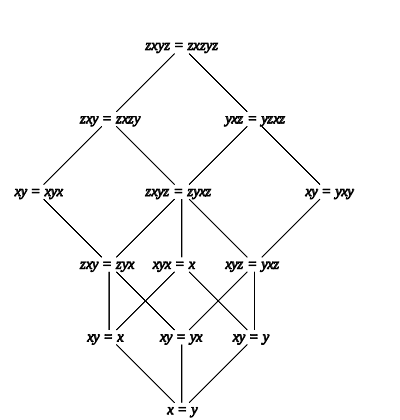Band (mathematics)
In mathematics, a band (also called idempotent semigroup) is a semigroup in which every element is idempotent (in other words equal to its own square). Bands were first studied and named by A. H. Clifford (1954); the lattice of varieties of bands was described independently in the early 1970s by Biryukov, Fennemore and Gerhard.[1] Semilattices, left-zero bands, right-zero bands, rectangular bands, normal bands, and regular bands, specific subclasses of bands which lie near the bottom of this lattice, are of particular interest and are briefly described below.
Varieties of bands
A class of bands forms a variety if it is closed under formation of subsemigroups, homomorphic images and direct product. Each variety of bands can be defined by a single defining identity.[2]
Semilattices
Semilattices are exactly commutative bands; that is, they are the bands satisfying the equation
- xy = yx for all x and y.
Zero bands
A left zero band is a band satisfying the equation
- xy = x,
whence its Cayley table has constant rows.
Symmetrically, a right zero band is one satisfying
- xy = y,
so that the Cayley table has constant columns.
Rectangular bands
A rectangular band is a band S which satisfies
- xyx = x for all x, y ∈ S.
Equivalently,
- xyz = xz.
For example, given arbitrary non-empty sets I and J one can define a semigroup operation on I × J by setting
The resulting semigroup is a rectangular band because
- for any pair (i, j) we have (i, j) · (i, j) = (i, j)
- for any two pairs (ix, jx), (iy, jy) we have
In fact, any rectangular band is isomorphic to one of the above form. Left zero and right zero bands are rectangular bands, and in fact every rectangular band is isomorphic to a direct product of a left zero band and a right zero band. All rectangular bands of prime order are zero bands, either left or right. A rectangular band is said to be purely rectangular if it is not a left or right zero band.[3]
Normal bands
A normal band is a band S satisfying
- xyzx = xzyx for all x, y, and z ∈ S.
This is the same equation used to define medial magmas, and so a normal band may also be called a medial band, and normal bands are examples of medial magmas.[3]
Regular bands
A regular band is a band S satisfying
- xyxzx = xyzx for all x, y, z ∈ S
Lattice of varieties

When partially ordered by inclusion, varieties of bands naturally form a lattice, in which the meet of two varieties is their intersection and the join of two varieties is the smallest variety that contains both of them. The complete structure of this lattice is known; in particular, it is countable, complete, and distributive.[1] The sublattice of the 13 varieties of regular bands is shown in the figure. The varieties of left-zero bands, semilattices, and right-zero bands are the three atoms (non-trivial minimal elements) of this lattice.
See also
Notes
- ↑ 1.0 1.1 Biryukov (1970); Fennemore (1970); Gerhard (1970).
- ↑ Fennemore (1970).
- ↑ 3.0 3.1 Yamada (1971).
References
- Biryukov, A. P. (1970), "Varieties of idempotent semigroups", Algebra and Logic 9 (3): 153–164, doi:10.1007/BF02218673.
- Clifford, Alfred Hoblitzelle (1954), "Bands of semigroups", Proceedings of the American Mathematical Society 5: 499–504, doi:10.1090/S0002-9939-1954-0062119-9, MR 0062119.
- Clifford, Alfred Hoblitzelle; Preston, Gordon Bamford (1972), The Algebraic Theory of Semigroups, Moscow: Mir.
- Fennemore, Charles (1970), "All varieties of bands", Semigroup Forum 1 (1): 172–179, doi:10.1007/BF02573031.
- Gerhard, J. A. (1970), "The lattice of equational classes of idempotent semigroups", Journal of Algebra 15 (2): 195–224, doi:10.1016/0021-8693(70)90073-6.
- Nagy, Attila (2001), Special Classes of Semigroups, Dordrecht: Kluwer Academic Publishers, ISBN 0-7923-6890-8.
- Yamada, Miyuki (1971), "Note on exclusive semigroups", Semigroup Forum 3 (1): 160–167, doi:10.1007/BF02572956.

